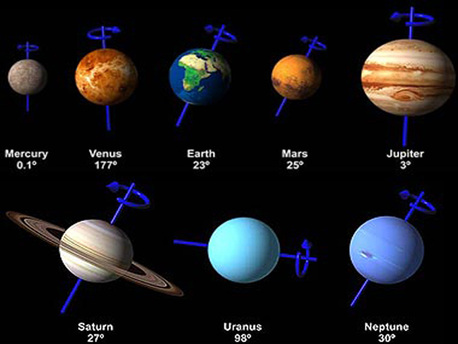Rotational Axes – total disorder
Why do the planets break ranks?
 |
The illustration shows that the axes of rotation of the planets in our solar system are tilted to various degrees. This was probably caused by collisions among the protoplanets from which the planets were formed. (c) Calvin J. Hamilton
When the Sun, planetesimals and, later, planets developed, the angular momentum of the rotating disc was preserved – part of it in the rotation of the Sun and planetesimals around their own axes. The axes of rotation of the Sun and planetesimals – that is, the line around which the bodies rotate – were probably perpendicular to the plane of the original disc.
The planetesimals of the inner solar system formed approximately a hundred protoplanets. They collided and created the planets as we know them today. These collisions probably tilted the axes of rotation of the planets away from being perpendicular to the plane of the original disc (and shifted the orbital planes of the planets around the Sun in relation to one another).
The axes of rotation of the planets – total disorder
The axis of rotation of Earth, which passes through the north and south poles, is not perpendicular to the plane of Earth’s orbit around the Sun – it is tilted by about 23.4 degrees. This inclination gives rise to the seasons on Earth.
The axes of rotation of Venus and Uranus are particularly pronounced in their inclination. With Venus, the axis of rotation is tilted by 177 degrees, which means that the axis is almost perpendicular again – but upside down. Venus rotates in the opposite direction to the other planets and one Venusian day last slightly longer than one Venusian year. With Uranus, the tilt is 98 degrees – so the planet appears to 'roll' around the Sun and once a (Uranian) year the Sun is positioned above each of the planet’s poles.
German Aerospace Center
Rotational Axes – total disorder
Why do the planets break ranks?
 |
The illustration shows that the axes of rotation of the planets in our solar system are tilted to various degrees. This was probably caused by collisions among the protoplanets from which the planets were formed. (c) Calvin J. Hamilton
When the Sun, planetesimals and, later, planets developed, the angular momentum of the rotating disc was preserved – part of it in the rotation of the Sun and planetesimals around their own axes. The axes of rotation of the Sun and planetesimals – that is, the line around which the bodies rotate – were probably perpendicular to the plane of the original disc.
The planetesimals of the inner solar system formed approximately a hundred protoplanets. They collided and created the planets as we know them today. These collisions probably tilted the axes of rotation of the planets away from being perpendicular to the plane of the original disc (and shifted the orbital planes of the planets around the Sun in relation to one another).
The axes of rotation of the planets – total disorder
The axis of rotation of Earth, which passes through the north and south poles, is not perpendicular to the plane of Earth’s orbit around the Sun – it is tilted by about 23.4 degrees. This inclination gives rise to the seasons on Earth.
The axes of rotation of Venus and Uranus are particularly pronounced in their inclination. With Venus, the axis of rotation is tilted by 177 degrees, which means that the axis is almost perpendicular again – but upside down. Venus rotates in the opposite direction to the other planets and one Venusian day last slightly longer than one Venusian year. With Uranus, the tilt is 98 degrees – so the planet appears to 'roll' around the Sun and once a (Uranian) year the Sun is positioned above each of the planet’s poles.
German Aerospace Center






